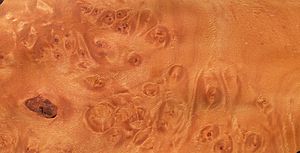Wood grain facts for kids
Wood grain describes the look and feel of the tiny fibers that make up wood. It's super important for anyone working with wood, like when you're cutting or sanding. Knowing the grain helps you work with the wood, not against it!
The way wood fibers grow in a tree creates different types of grain. Let's explore some of them.
Contents
Basic Wood Grain Types
The basic types of wood grain describe how the wood fibers are aligned in the tree.
Straight Grain
- Straight grain means the wood fibers run in one direction, mostly parallel to each other. This happens when a tree grows straight up without much twisting. It's often the easiest type of wood to work with.
Cross Grain
- Cross grain happens when some wood cells grow outwards from the main part of the tree trunk. This can make the wood a bit trickier to cut smoothly.
Spiral Grain
- Spiral grain forms when the tree trunk twists as it grows. Imagine a spiral staircase inside the tree! This twisting makes the wood fibers follow a spiral path.
Interlocked Grain
- Interlocked grain is like a super spiral grain. It happens when the growth rings in a twisting tree trunk develop with fibers that keep changing direction. They interlock, making the wood very strong but also challenging to work with. It's sometimes called roey grain.
Special Wood Grains
Some wood grains are very rare and beautiful. Their unique patterns make the wood more valuable for special projects.
- Bird's eye grain looks like tiny, swirling eyes scattered across the wood.
- Quilted grain creates a wavy, three-dimensional pattern, like a soft quilt.
- Fiddleback grain has a wavy, striped pattern that looks like the back of a violin.
- Curly grain shows wavy lines that seem to curl through the wood.
- Tiger grain has bold, dark stripes that resemble a tiger's markings.
Wood Grain and Woodworking
When you're working with wood, the direction of the grain matters a lot!
- With the grain: This means you are cutting or sanding in the same direction as the wood fibers. It usually gives the smoothest results.
- Against the grain: This means you are working in the opposite direction of the wood fibers. It can cause the wood to tear or splinter, making it harder to get a clean finish.
- Across the grain: This means you are cutting or sanding across the width of the wood fibers, at a right angle to them.
How Wood is Cut: Grain Directions
The way a piece of wood is cut from the tree also affects how its grain looks and behaves.
- Flat-grain: Also called flat-sawn or plain sawn. This is the most common way to cut wood. The cuts are made parallel to the tree's growth rings, which often creates a wide, arching grain pattern.
- Edge grain: Also known as quarter-sawn or rift-sawn. This method cuts the wood at an angle to the growth rings. It produces straight, parallel grain lines that are very stable and less likely to warp.
- End grain: This is the view of the wood when you look at the very end of a board, where the growth rings are visible as circles or ovals. End grain is very absorbent and strong when pressed from above.
Images for kids
-
The weathered trunk of a lodgepole pine tree showing an extremely spiral grain.





